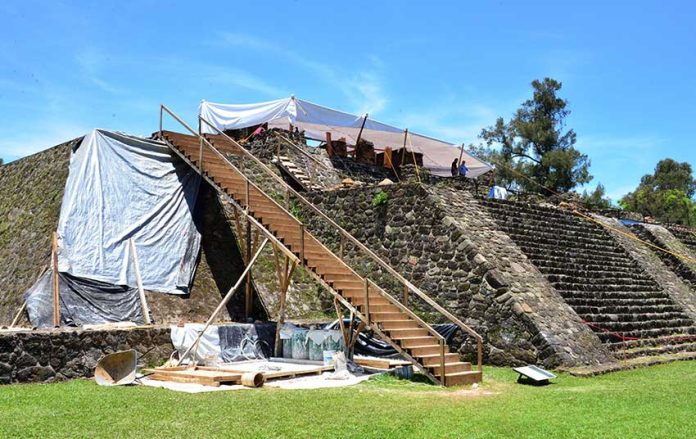Last September’s second major earthquake caused widespread damage in central Mexico and claimed hundreds of lives but it also helped to reveal a tightly-held archaeological secret in the state of Morelos.
While carrying out post-quake restoration work on the main pyramid at the Teopanzolco archaeological site in Cuernavaca, archaeologists from the National Institute of Anthropology and History (INAH) found the remains of a temple inside the structure.
INAH Morelos director Isabel Campos Goenaga explained that the discovery of the substructure was made while carrying out exploratory drilling of the pyramid to determine its structural integrity after it was damaged in the September 19 earthquake.
She also said the find indicates that the site built by the Tlahuica people dates back to the early stages of the Mexica period, which makes it older than previously thought.
“Despite the damage the earthquake caused we have to be thankful that because of this natural phenomenon, this important structure appeared that changes the dating of the archaeological site,” Campos said.
The discovery includes walls of what is believed to have been a temple and the remains of a stucco column that probably supported a roof.
No remains of a roof were found, however, leading archaeologists who worked on the project to believe that it may have been made out of a biodegradable material.
The archaeologists contend that the architectural relics date back to the first construction phase of the pyramid during the middle of the Post-classic period, or between 1150 and 1200 AD.
In addition, they claim that the structures built at Teopanzolco served as a source of inspiration for the inhabitants of Tenochtitlán, the Aztec capital that became Mexico City.
“This discovery changes the chronology of Teopanzolco because an open-air basement was built first and then, in the image of this type of construction, the Templo Mayor [Main Temple] of Tenochtitlán was built,” INAH archaeologist Bárbara Konieczna said.
“The Mexicas [Aztecs] didn’t bring this architectural style to the region, on the contrary, the Tlahuica constructions inspired them to build the Templo Mayor,” she added.
Konieczna and her colleague Georgia Yris Bravo López think there may have been another temple on the site.
The newly-uncovered temple may have been dedicated to Tláloc — the god of rain — while if, as suspected, another place of worship exists, it may have been dedicated to Huitzilopochtli — the deity of sun, war and human sacrifice, Konieczna said.
The archaeologists also recovered ceramic artifacts and a censer featuring Tlahuica motifs as well as a significant amount of charcoal that could have been left over from either rituals carried out at the temple or from a disaster.
The recovered pieces will undergo testing to determine their approximate age.
Mexico News Daily
